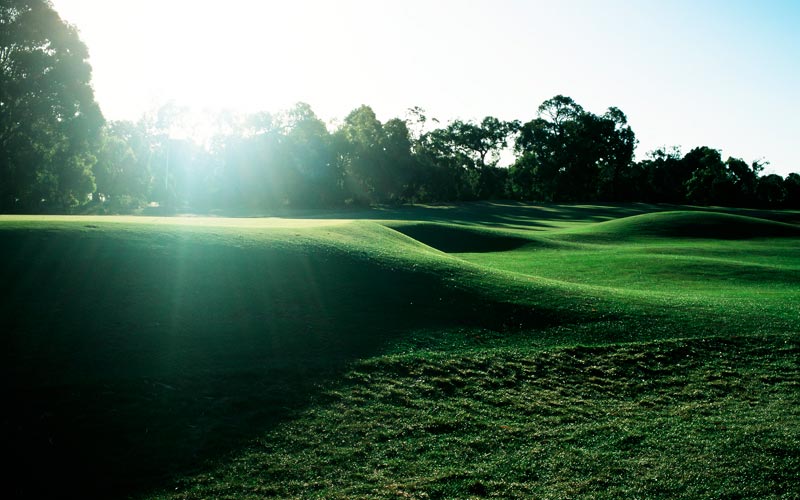The Short Par Fours of the Sandbelt
by Mark Ferguson
Tantalising yet torturous, the great short par four is often a scarcity, or perhaps an afterthought, in modern design, yet essential to any course hoping to forever capture a golfer’s long term interest.
On the craggy links of the United Kingdom and Ireland, the dramatic folds and tumbles of the ancient land lent itself perfectly to the creation of holes that are capable of being played by all, yet can frustrate the better or more powerful golfer through the ingenuity of their design. Venerable architects such as Old Tom Morris, James Braid, Harry Colt, Tom Simpson and Dr Alister MacKenzie were masters at turning 300 yards of wind-tossed terrain into a superlative golf hole.
Hemmed in now as part of a conglomeration of four million people, the Sandbelt of suburban Melbourne is nevertheless situated very near Port Philip Bay, and a gentle breeze or scything wind – either icy or furnace-like, even on the same day – are as likely to be your company as on many a links course.
Founded by immigrants from the UK, as often as not designed or built by the members and course staff themselves as opposed to professionals seeking to create a more standard championship test, it was only natural that the courses that comprise this famous stretch of terrain all feature an abundance of these holes to either torment or delight the visitor and member alike.
Royal Melbourne’s West course has its 3rd and 10th holes, the East the 5th and 11th; near neighbour Kingston Heath has the 3rd, 9th and 13th, Victoria has the enticing 15th, Commonwealth, despite seeing several of its best holes obliterated by unfortunate changes, has left its superb 17th hole intact, whilst the underrated and oft-forgotten Woodlands has the 4th, 7th and 13th to showcase as holes worthy of celebration by anyone fascinated as to how such modest yardage can stall even the mightiest challenge. And, on the edge of the Sandbelt, the Peninsula Country Golf club has two courses featuring several classic examples.
In the Sandbelt’s case, it is swift, boldly contoured and sloped greens coupled with the stunning bunkering that is as lethal to play from as it is beautiful to look at. The temptation for the better player to make a formidable carry, squeeze a booming tee shot between native vegetation and the sprawling sand traps, or simply stay on a tiny elevated plateau green is often overwhelming, especially for overseas visitors who will not find a collection of similar holes anywhere else in the world no matter the breadth of their travels.
The putting surfaces at these revered layouts are as smooth and swift as anyone is likely to encounter, especially in the late summer and early autumn (February to April) when the ground will be dried out and firm, the ball rolling distressingly unforeseen distances, demanding imagination, control and ingenuity, the very qualities that are as likely to fascinate the golfer the hundredth time as the first.
Well, perhaps not the first…
Royal Melbourne West, 3rd Hole
A mere 324 metres of ingenuity, this hole perfectly embodies Dr. Alistair Mackenzie’s design ethos. A wide, seemingly hazard-free fairway falls over a slight crest; the triangular green up ahead continues to fall away from the golfer, as well as slope hard from left-to-right, away from a typically fearsome set of bunkers, yet a deep and beautifully crafted swale protects the front of the green along with more sand. Stopping a ball from a downhill lie on such a green is never easy, and recovery shots from the swale have the distressing habit of returning to one’s feet if too gentle a touch is applied.
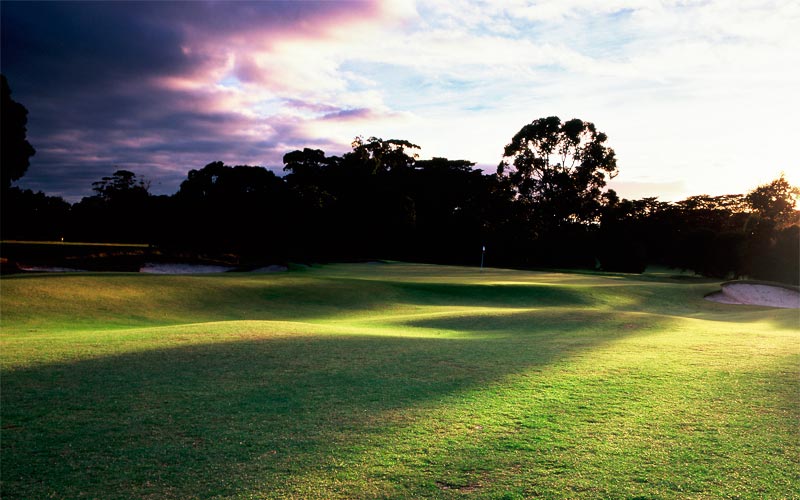
The construction genius of Mick Morcom and Alex Russell is never more apparent than on the West Course’s third hole.
Kingston Heath, 3rd Hole.
Another seemingly uncomplicated hole, again it is the approach shot that induces a nervous twitch, even after a perfectly placed tee shot.
One of the flatter fairways on the course, six of its eight bunkers are located in the last third of the hole; two bunkers guards the ideal line on the left side of a fairway lined with unplayable vegetation. The choice from the tee is whether to drive past the bunker, alongside or take it out of play by laying up short. Another possibility exists for the more adventurous; driving into the front bunker guarding the green in the hope an up and down provides a birdie.
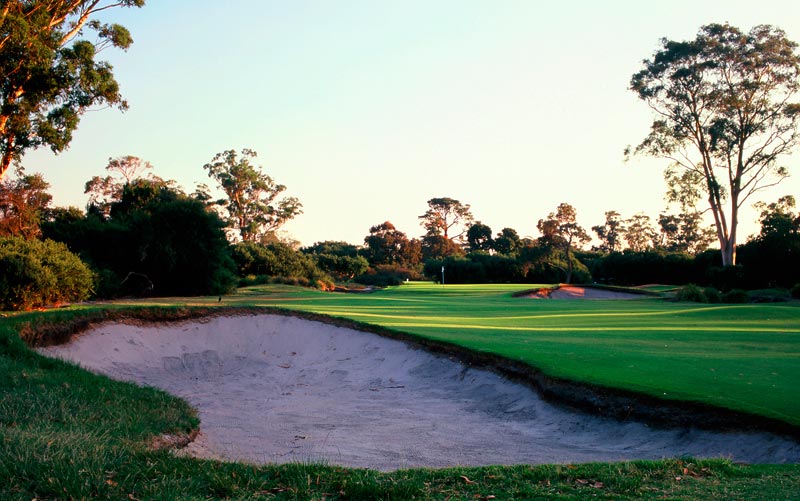
The lack of a great piece of land hasn’t stopped Kingston Heath’s third hole being regarded as one of Australia’s great short par fours.
For most, the pitch is nerve-wracking, to a small, narrow and slightly raised green that slopes sharply from back to front. Even if the ideal line is achieved off the tee, a swale in front of the green ensures the resulting pitch must be weighted correctly. Incorrect placement of the approach can leave putts that break three feet or more, with the ball only stopping if it runs into the hole.
Peninsula North, 8th Hole.
On the card, and indeed from the tee, the ever tantalising prospect of driving the green for an eagle would appear to be a forlorn prospect. However, running sharply downhill as well as bending hard from right to left, the player who can carry the sprawling traps on the corner 255 metres away could bounce forward onto the flattish green. Of course, missing could mean a horrible long bunker shot or, worse, a hack from native vegetation, but the prospect is often too thrilling to ignore.
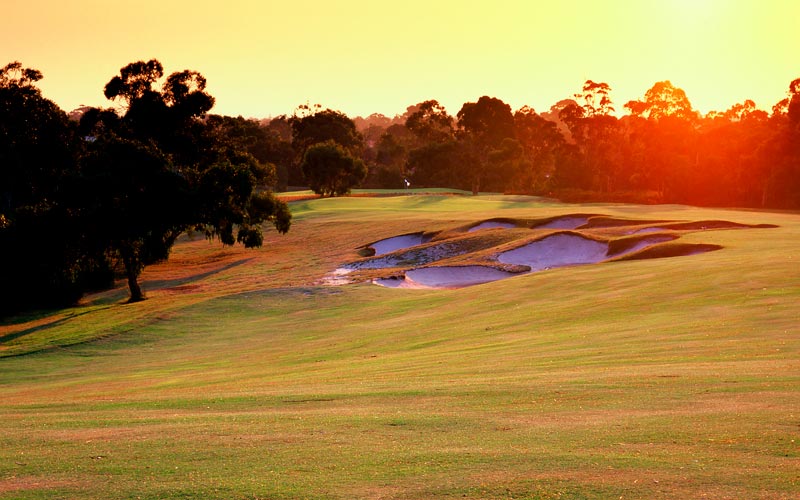
There’s a good reason people consider Peninsula’s North course to be the best land for golf outside of Royal Melbourne’s main paddock!
Commonwealth, 17th Hole.
Apparent simplicity is the essence of much of Commonwealth, and no more so than with this beautiful hole.
A mere 307 metres, the fairway rises gently, with a slight slope from the centre across to the right. Those who drive through the almost insignificant right-to-left dogleg will find themselves having to play a half-wedge shot to a smallish green angled from front right to back left, guarded by a beautifully shaped bunker, with a gaping swale eating greedily into the right hand side of the green for good measure.
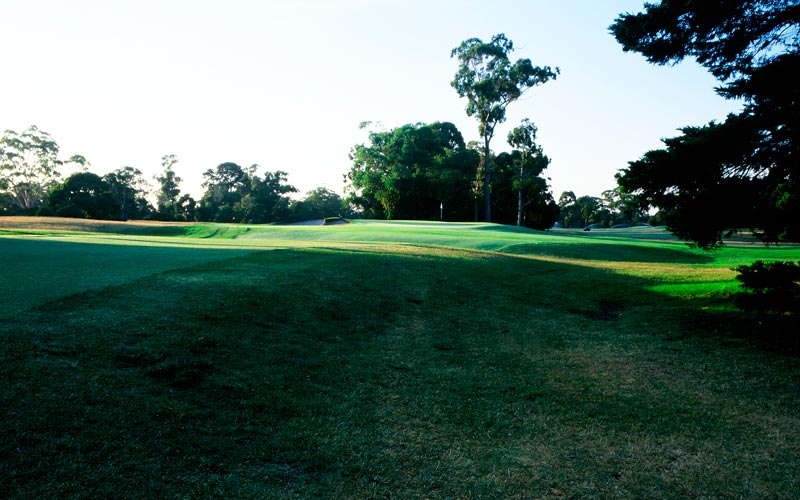
The subtlety of such skilful construction becomes apparent when an apparently fine drive is pushed away from it’s ideal position on Commonwealth’s 17th hole.
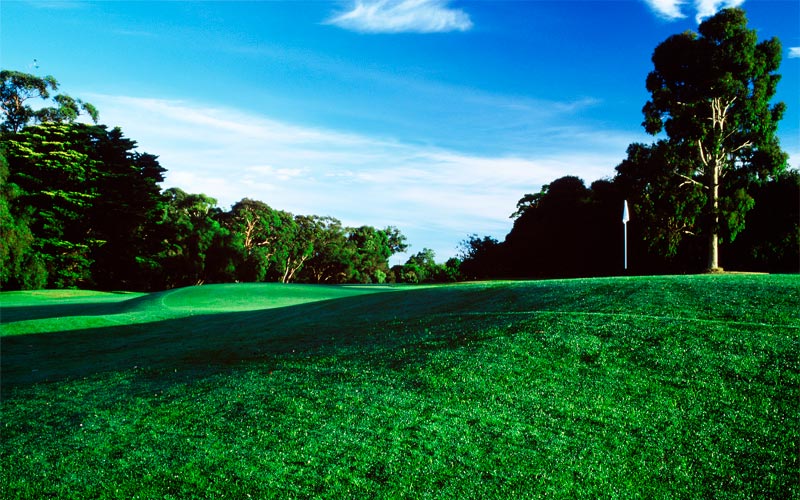
The necessity of playing your approach shot from the correct angle, as well as with the proper weight, is apparent from behind Commonwealth’s beautiful 17th green.
As if that wasn’t enough, the rear of the green slopes alarmingly away off a plateau, making it all the more imperative that the tee shot be held up against the right side of the fairway, which is pockmarked with hollows best kept away from.
Woodlands, 4th Hole.
A paltry 251 metres, with an unguarded green and a fairway bunker that only comes into play for those unfortunately topping their drive, this would appear to be a hole any reasonably competent golfer will gleefully demolish.
The green, however, is a meagre little shelf, only nine metres across at the front, scarcely wider at the rear and perched defiantly on a plateau. A golfer playing their second shot from anywhere other than straight away has almost no green to work with, and with the Woodlands greens renowned for their concrete-like hardness, it requires a rare mixture of imagination, touch and dexterity to walk away with a four after a misguided drive.
Woodlands, 13th Hole.
A golfer paying attention at Woodlands will have noticed by now that most of the greens are best attacked from the outside of the dogleg. At the 293 metre 13th hole, that means taking on a pair of perfectly placed bunkers on the left hand side of the left-to-right turning fairway.

Another potentially driveable par four at Woodlands , the 13th green needs a perfectly shaped tee shot to avoid potential disaster.
Again, the green is a somewhat stingy little shelf, angled towards the outside of the turn, deep bunkers guarding its right front and sides, and any manner of knolls and bumps carved into the surrounding terrain opposite.
The green is small but beautifully contoured, allowing for an infinite variety of approaches; a full pitch to rear flag locations, pitch and run to front locations. The confounding nature of the bumpy terrain surrounding the green means any sideways miss requires extraordinary touch to get close enough for a sure putt, whether the putt is for a three or four. Missing right leaves one of the worst bunker shots in golf.
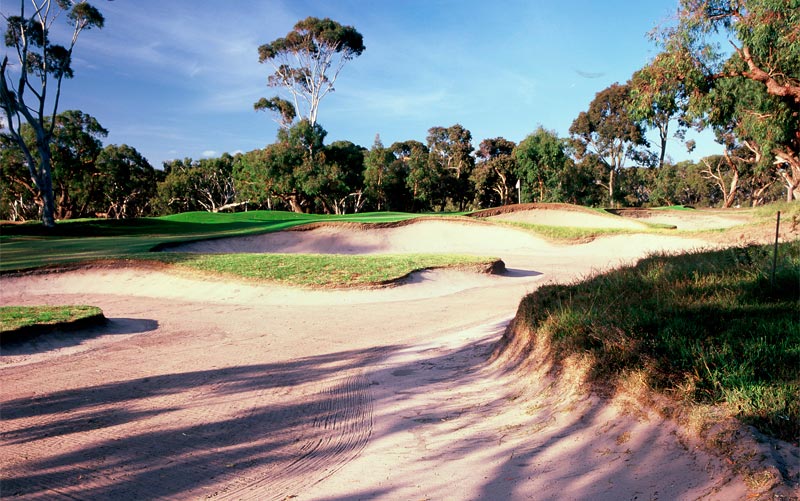
Many holes at Woodlands have bunkers extending a long way from the green, no more so than on the right hand side of the 13th green.
Victoria, 15th Hole.
The 15th hole at this esteemed and elegant club is all the proof that is needed that length is a forlorn defence against the best players in the world. The truncated 2002 Australian Open saw the newly lengthened 9th and 17th holes, each playing over 530 metres, yet players still managed to negotiate them both in less than five strokes each more often than not.
The beguiling 297 metre 15th, its slight right-to-left leaning fairway, its grasping bunkers that flank both sides close to the green gradually choking off fairway width, proved a more difficult beast to conquer.
Depending on the requisite amount of boldness, any club from driver through to mid-iron can be chosen from the tee. As the green follows the fairway in sloping from right-to-left, the left side of the fairway is the preferred option in order to hold the green, which is perched upon a pulpit from where the over hit approach could distressingly end up on another fairway.
Attempting to drive the green and missing leaves the dreaded thirty-metre bunker shot, whilst a safe iron from the tee often means the second shot is played from that awkward distance between 50 and 80 metres. Cleverly, the further from the tee you wish to hit, the more the landing area is blind.
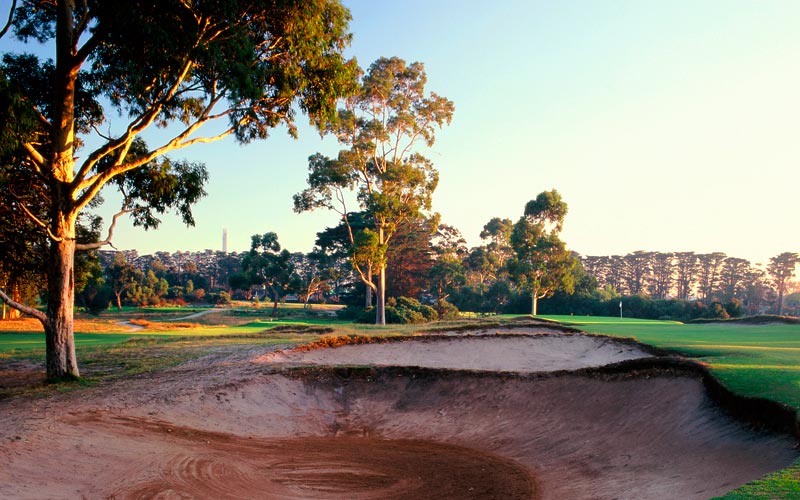
The further a player drives from the tee, the more these ancient bunkers on Victoria’s 15th hole both narrow and visually impair the landing area of the tee shot.
Peninsula South, 7th Hole
Always the longer and stronger of the two courses at this fine club on the edge of the Sandbelt, when redesigned by Barnbougle Dunes co-designer Mike Clayton in 2006, several short par fours were pleasingly created to tempt and confound, with this a mere 299 metres.
A long, waste-area like bunker guards almost the entire right hand side of the left-to-right dogleg, guarding the ideal line into the bunkered green. It’s possible to drive the green, but miss in the wrong spot, and a five is almost certain. Shots leaked left from the tee require a deft pitch to stay on a green nestled between guarding bunkers.
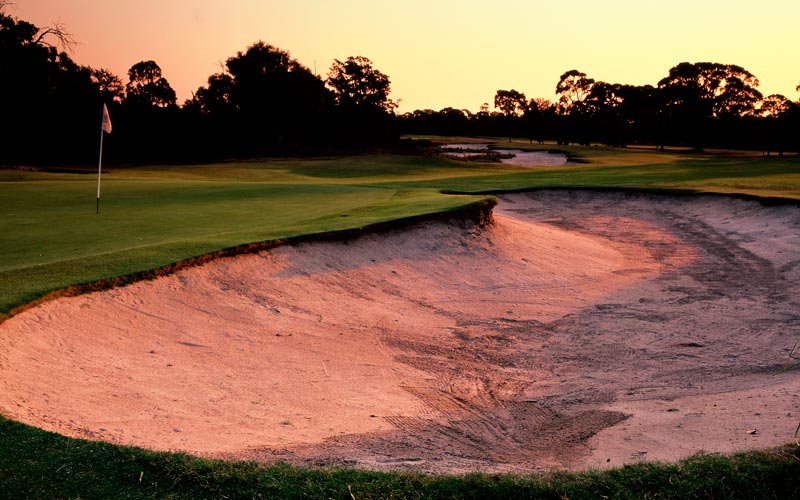
As with so many of Melbourne’s short fours, ambition often overwhelms aptitude, as it can here on Peninsula South’s 7th hole.
Royal Melbourne East, 5th Hole.
The outer paddocks of the East course have not the movement and grandeur of the main paddock, but there is usually enough undulation to affect play, none more so on this 317 metre hole, perhaps the most unsung short four in Melbourne.
Although technology has somewhat blunted the effect of the right-to-left slope that creates a semi-blind tee shot, it can still have the effect of slinging the improperly hit drive further left than desirable, where the approach must then be played over bunkers to a now semi-blind green. Staying on the slope however, may be worse; another bunker guards the right front, just where an approach will need to land to stay on a putting surface which falls away in several directions. A precise tee shot of around 220 metres centre right is needed for an unimpeded pitch to a green made smaller by the greedy nature of its guardian bunkers, its front to back tilt, and the insidious fall offs.

An approach shot not properly thought out or struck on the East course’s 5th hole will only need to hit the green in the wrong spot to tumble away, where hitting the green in three is suddenly more difficult than hitting it in two.
Peninsula South, 1st Hole.
From a tee high above the fairway tumbling away below, the first shot of the day is a thrilling prospect. A solitary bunker on the right hand side of the fairway lies in wait for those of whom that first strike is more likely to be iron or hybrid than wood, whilst the snaking dry creek which runs the left of the fairway to cross in front of the green, provides the challenge to the more difficult pin positions on the right hand side of the beautifully contoured green, if striking the ball purely from a downhill stance wasn’t enough challenge.

Given the downhill nature of the tee shot, this dry creek comes alarmingly into play more than it appears it could, thus getting the day off to an imperfect start on Peninsula’s South course.
Peninsula North, 6th Hole.
Uphill holes are rarely so thrilling a prospect from the tee as here. A diagonal line of bunkers carved into the left middle side of the fairway are perfectly placed to allow an open second shot to the bunkered green at the top of the hill.
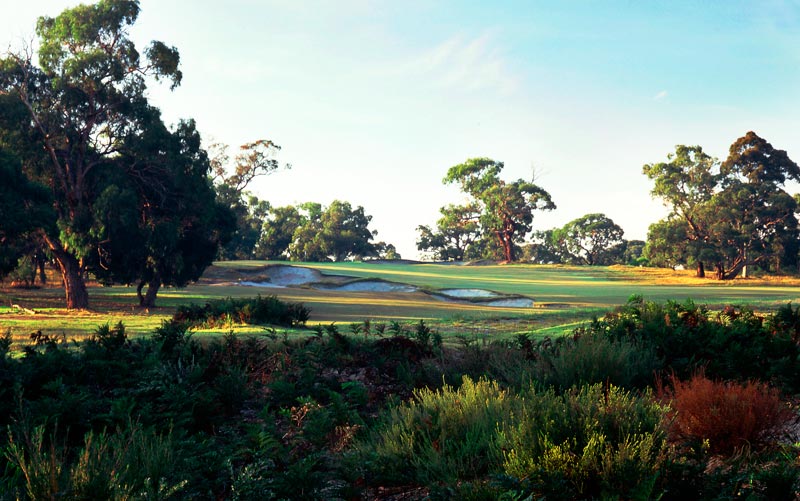
In an age when many Sandbelt courses have removed vegetation in front of the tee, Peninsula North’s 6th hole shows it still has a role to play with this classically Australian setting.
Perfect tee shot placement still leaves a fiddly uphill lie to contend with, with the certain knowledge that second shots not quite strong enough could tumble thirty yards back into the fairway. The green is a somewhat modest affair, but there is enough gentle contour to confound the careless, particularly if the flag is placed close to the bunker, where, in typical Sandbelt fashion, a shoulder from the trap flows into the green.
Peninsula North, 13th Hole.
Imitation being the sincerest form of flattery, it is a pity the designers of Woodlands’ 4th green aren’t around to bask in the influence their hole has. Whilst a perfectly placed bunker some 230 metres away on the left protects the ideal line into a tiny three-tiered green perched upon a slight plateau, a bunker benched into the rolling hillside further back on the right side of the fairway narrows the drive more so than it appears from the tee.
Although not as raised as the green upon which it is based, the green still requires a perfect pitch, especially to a flag at the back of the putting surface, where to over hit the approach would be disastrous.
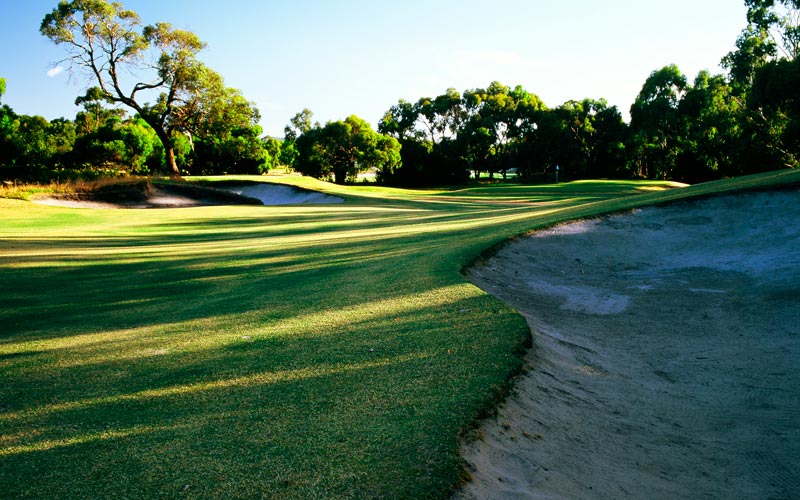
Modeled on Woodlands’ 4th hole, the tiny tiered green requires an accurate drive through a tightly bunkered chute for the ideal angle.
Woodlands, 7th Hole.
With the green typically opening up better from the outside, that unfortunately means a brave drive into a narrow neck of fairway on this 341 metre hole. Anything pushed right will find a wispy kink of fairway, or worse, trees, from where it will be next to impossible to impart the requisite spin needed to stop the ball on the unusually shaped green, which resembles an upside down boomerang.

Woe betide the player without their game, and more importantly, their thought processes, working on Woodlands’ 7th hole
The approach shot from the left side of the fairway isn’t a particularly attractive prospect, needing to fly over 25 metres of sand and stop suddenly lest it find more. An approach shot leaked to the right has a subtle but devilish little mound to confound the chip back.
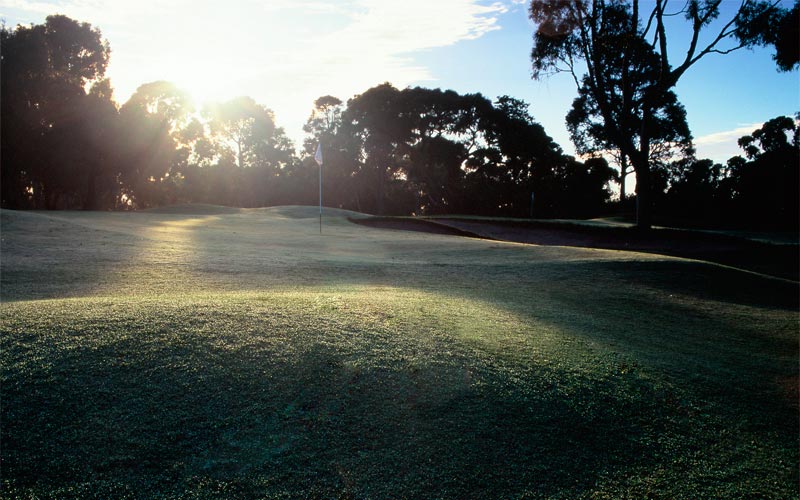
The skillful yet subtle construction of Woodlands’ green complexes makes apparently trouble-free approach shots anything but.
Royal Melbourne East, 11th Hole.
At 329 metres and with a wide open fairway, all would seem welcoming. Aside from the fact that the drive is blind over the crest of a hill, and the perfect line on the right edge of the fairway suddenly seems as unobtainable as ever.

As with so many of Melbourne’s great short fours, yardage is irrelevant when confronted with skilful construction and intelligent design, such as the 11th hole on the East course.
The green is narrow, wedged between a cavernous trap protecting the right hand side, a smaller one protecting the front left, and a severe swale that eats into the left middle of the green. Being pin high either side requires a deftness and surety of touch many will lack. So to does over the back.
The End


